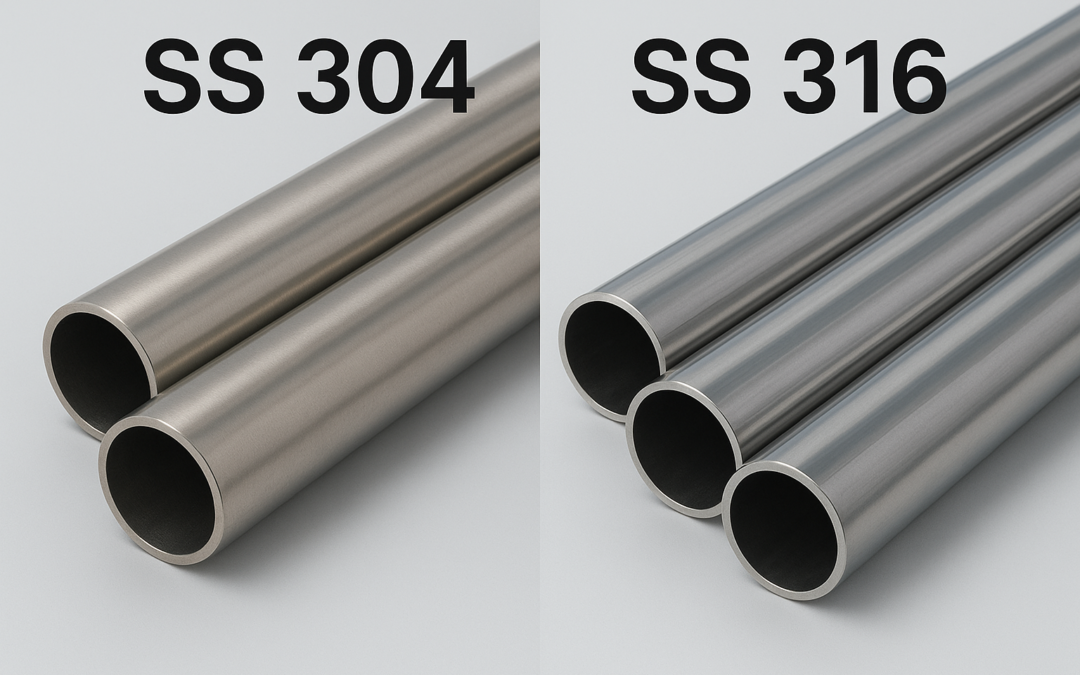| SS 304 (18-8 Stainless Steel) | SS 316 (18-10 Stainless Steel) | |
| Corrosion Resistance | Good | Excellent |
| Pitting Resistance | Moderate | High |
| Crevice Corrosion Resistance | Moderate | High |
| Stress Corrosion Cracking Resistance | Moderate | High |
| Heat Resistance | Up to 870°C | Up to 870°C |
| Cost | Less expensive | More expensive |
See The Difference Between 18-8 and 18-10 Stainless Steel.
| Property | 18/8 Stainless Steel | 18/10 Stainless Steel |
| Nickel Content | 8-10.5% | 10-14% |
| Chromium Content | 18-20% | 16-18% |
| Tensile Strength | 515 MPa | 515 to 730 MPa |
| Yield Strength | 205 Mpa | 200 to 215 Mpa |
| Elongation | Around 40% | Around 45% |
| Temperature | up to 925°C (1700°F) | up to 870°C (1600°F) |
Find Material-wise Differences Between 304 and 316 Stainless Steel
Material Difference Between Stainless Steel Types 304 and 316
| Stainless Steel 304 | Stainless Steel 316 | |
| Material | Austenitic Stainless Steel | Austenitic Stainless Steel |
| Chromium Content | 18% | 16-18% |
| Nickel Content | 8% | 10-14% |
| Carbon Content | Up to 0.08% | Up to 0.08% |
| Molybdenum Content | Not present | 2-3% |
View the application-specific differences between stainless steel 304 and 316.
Application-Specific Difference Between 304 and 316
| SS 304 | SS 316 | |
| Applications | Storage tanksDecorative trimAppliancesKitchen equipmentWheel coversWater pipingAutomotive trimIndoor electrical enclosures | Pharmaceutical equipmentCommercial kitchen surfaces, equipment, and appliancesStructural steel and components in marine environmentsChemical equipmentMedical equipmentStainless steel floatsChemical piping |
| Uses | General-purpose use in less corrosive environments | Ideal for use in highly corrosive environments, such as marine and chemical industries |
Find Strength-Wise Differences Between SS 304 and SS 316.
SS 304 Vs 316 Strength
| 304 Stainless Steel | 316 Stainless Steel | |
| Tensile Strength | 500-700 Mpa | 400-620 Mpa |
| Hardness (Brinell) | 215 Max HB | 149 max HB |
| Elongation A50 mm | 45 Min % | 45% min |
| Melting Point | 1450℃ | 1400℃ |
| Density | 8.00 g/cm^3 | 8.00 g/cm^3 |
| Thermal Expansion | 17.2 x10^-6/K | 15.9 x 10^-6 |
| Modulus of Elasticity | 193 GPa | 193 GPa |
| Thermal Conductivity | 16.2 W/m.K | 16.3 W/m.K |
Check the Pros and Cons of 304 and 316 Stainless Steel.
Pros and Cons of 304 Stainless Steel.
SS 304/18-8 stainless steel/A2 Stainless
Because the chemical composition of 18-8 and 304 stainless steel is the same, they are often referred to as the same material. The 18-8 represents the chemical composition, which is 18% chromium and 8% nickel, giving it outstanding corrosion resistance. There are two more grades of 304: 304L, which is low carbon, and 304H, which is high carbon, in addition to 304, which is a general grade. SS 304 is also known as A2 stainless.
Pros
• High corrosion resistance
• Less heat sensitive than 302
• Stronger than mild steels
Cons
• Vulnerable to saltwater corrosion.
• Requires proper tools to machine well
304/18-8 SS should be used when the low cost is more important than corrosion resistance and not working in a marine environment and product is not exposed in a corrosive environment.
Application of 304(18-8 Stainless steel)
• Appliances such as refrigerators & dishwashers
• Commercial food processing equipment
• Heat exchangers
• Structures in atmospheres that would corrode standard carbon steel.
316 Stainless Steel Pros And Cons
SS 316/18-10 stainless steel/A4 Stainless
SS 316 includes 16% chromium, 10% nickel, and other constituents, hence it is also known as 18-10 stainless steel. Other grades of SS 316 are 316L (low carbon), 316F (free machining), and 316N (high nitrogen). It is suitable for marine and high-salinity environments. It is also known as A4 stainless.
Pros
• Stronger than 304 stainless
• Extremely corrosion resistant
• performs well against pitting
• Resistant to salt water
• Resistant to caustic chemicals
Cons
• Requires the precise tools to machine well
• More expensive than 304
SS 316 is used when corrosion resistance is more significant than cost and if we are working in a marine environment and with corrosive chemicals.
Application of 316(18-10 Stainless steel)
• Chemical processing and storage equipment.
• Refinery equipment
• Medical devices
• Marine environments, especially those with chlorides present
Summary
So, depending on the working environment and the product budget, the best grade should be selected to construct a project so that it may endure for a longer period in a working environment since in some circumstances, SS 304 and SS 316 function better.
Newzel Industries is the largest metal supplier in the world. We are suppliers and exporters of ferrous and non-ferrous metal products. We supply stainless steel, carbon steel, nickel alloys, alloy steel, aluminum, monel, and inconel. For further information, please contact us.


